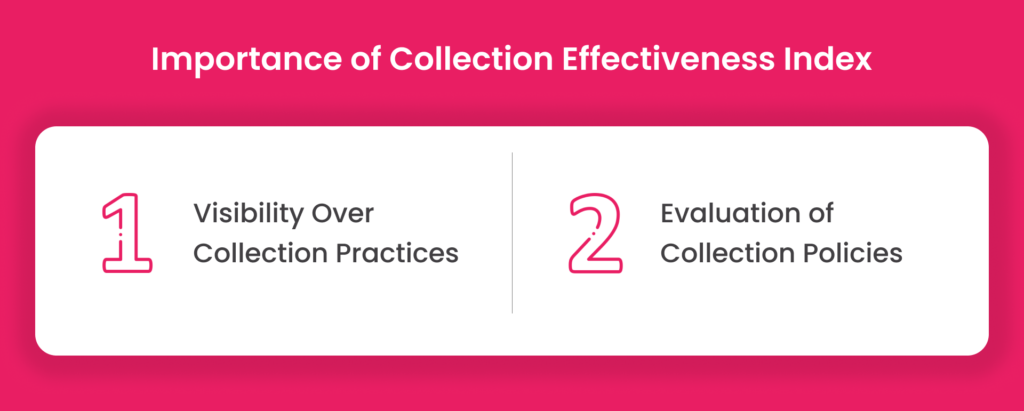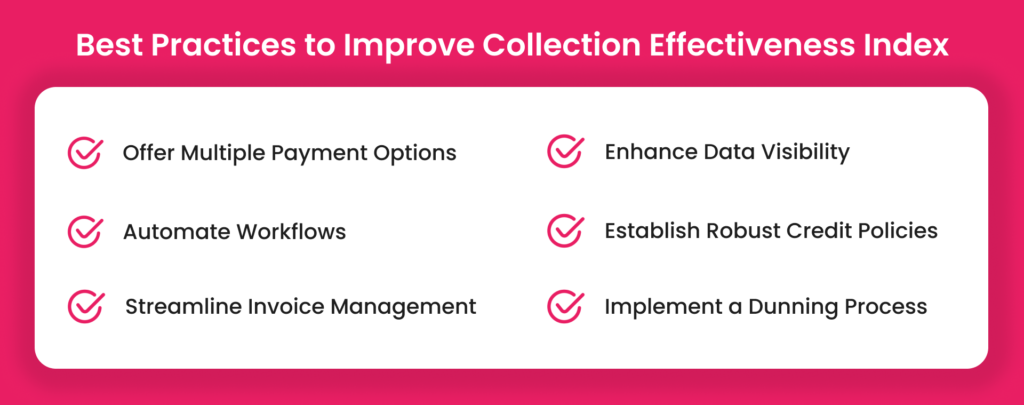The efficient handling of accounts receivable stands as a crucial pillar for the success of any business. Among other crucial accounts receivable metrics, one key performance indicator takes center stage: Collection Effectiveness Index (CEI). This metric is a crucial indicator of how efficiently a company collects on outstanding receivables.
In this blog, we’ll break down CEI from its definition and calculation to understanding what the numbers mean and practical steps to enhance the collection process.
What is the Collection Effectiveness Index (CEI)?
The Collection Effectiveness Index (CEI) is a key performance indicator that provides insights into how effectively a company is managing and collecting payments on its accounts receivable. In simple terms, CEI measures the collection efficiency of converting outstanding receivables into actual cash over a specific period.
The CEI shows how well a business turns sales into cash. It compares the cash collected during a specific time to the total cash that could have been collected, based on the opening and closing accounts receivable balances. The result is shown as a percentage, helping businesses see how effectively they collect payments.
A higher CEI indicates a more efficient and effective collection process, while a lower CEI may suggest challenges in collecting payments. Monitoring and analyzing the Collection Effectiveness Index can help businesses identify areas for improvement in their accounts receivable management, leading to better cash flow and financial health.
Why is the Collection Effectiveness Index Important?

Visibility over Collection Practices
The Collection Effectiveness Index (CEI) is an important metric that shows how well your payment collection process is working. A low CEI means your credit and collections team might need to improve their daily processes. It’s a clear way to measure how efficient your collections are.
Evaluation of Collection Policies
The Collection Effectiveness Index (CEI) is a useful way to measure how well your collection efforts are doing. You can use the CEI formula not just monthly but over longer periods too. It helps you see how effective your process is at managing receivables and overdue accounts, making it easier to improve your collection strategy.
How to Calculate Collection Effectiveness Index?
The Collection Effectiveness Index is easy to calculate. It uses a simple formula to show how well receivables are being collected over a month. Let’s break it down step by step.
Beginning Receivables: This represents the total open receivables at the start of the month. Interestingly, it mirrors the ending total receivables from the preceding month.
Monthly Credit Sales: This encompasses the sales made by extending credit during the current month.
Ending Total Receivables: This accounts for all open receivables, including both current and overdue, at the close of the month.
Ending Current Receivables: This specifically refers to the open receivables that are not yet overdue.
Now, let’s put it all together in the Collection Effectiveness Index formula:
| CEI=[(Beginning Receivables+Monthly Credit Sales−Ending Total Receivables) / (Beginning Receivables+Monthly Credit Sales−Ending Current Receivables)] X100 |
Let’s walk through an example to illustrate how to calculate the Collection Effectiveness Index using the provided formula.
Suppose XZY Inc. is analyzing its receivables for April:
- Beginning Receivables (April 1): $10 million (this is the same as the Ending Total Receivables from March 31)
- Monthly Credit Sales in April: $3 million
- Ending Total Receivables (April 30): $8 million
- Ending Current Receivables (April 30): $6 million
Now, plug these values into the CEI formula:
CEI=[($10 million+$3 million) − $8 million / ($10 million+$3 million) − $6 million] X 100
CEI=[($13 million−$8 million) / ($13 million − $6 million)] X 100
CEI=($5 million / $7 million) X 100
CEI ≈ 71.43%
The calculated CEI is approximately 71.43%. This means that XZY Inc. was able to collect about 71.43% of the cash that could have been collected during April, considering the dynamics of the receivables.
To understand this percentage, we need to check if it meets the business goals and matches industry standards. A Collection Effectiveness Index of 100% is perfect but not realistic. In most cases, a score of 80% or higher is considered good.
How to Interpret Collection Effectiveness Index?
Understanding and correctly interpreting the Collection Effectiveness Index is crucial for assessing receivable performance. Consider these factors for the interpretation of CEI:
Timely and Accurate Invoicing: Customers may not pay promptly if they don’t receive accurate and timely invoices.
Credit Policies and Payment Terms: Flexible credit practices and overly lenient payment terms can lead to a lower CEI.
Payment Flexibility: Customers have diverse payment preferences, and a lack of flexibility in payment options can affect cash collection.
Customer Prioritization: Efficient collection strategies involve prioritizing customers based on their payment behavior. If collectors spend too much time figuring out call priorities, it can lead to contacting the wrong customers and payment delays.
Proactive Collections Practices: Delays in payment reminder result in payment delay. Instead of waiting for invoices to become overdue, adopt a proactive approach to prevent payment delays.
How to Improve the Collection Effectiveness Index?
Improving the Collection Effectiveness Index involves regular monitoring and proactive measures. Here are some fundamental steps:

1. Offer Multiple Payment Options
Implement an accounts receivable solution that enables customers to make timely payments using their preferred payment method and currency.
2. Automate Workflows
Introduce automated workflows to the collections processes. This ensures timely delivery of invoices to the right contacts, with a focus on prioritizing high-risk accounts.
3. Streamline Invoice Management
Integrate accounts receivable solutions to ERP and accounting software to reduce manual data entry and invoice errors. Automate the invoice creation and delivery process for timely delivery.
4. Enhance Data Visibility
Provide AR teams with complete access to customer data, including payment history, communications, and contact details. This transparency aids in customer interactions, improves experiences, and reduces the chances of late payments.
5. Establish Robust Credit Policies
Develop and enforce strong credit policies based on factors like credit scores and payment history. Tailor terms to each customer appropriately to mitigate the risk of late payments.
6. Implement a Dunning Process
Despite proactive measures, late payments may occur. Have a well-defined dunning process in place to minimize the likelihood of delinquent accounts.
Closing Thoughts
To improve your Collection Effectiveness Index, it’s important to make your credit and collections process more efficient. A great way to do this is by using accounts receivable automation tools. These tools help you manage collections more effectively and smoothly, leading to better financial control.
Peakflo helps businesses improve their Customer Experience Index by making payments smooth and hassle-free. With its AI-powered Accounts Receivable solution, Peakflo sends smart reminders for due payments, ensuring customers stay on track without feeling pressured. It also personalizes communication based on customer behavior, creating a friendly and professional approach.
Peakflo’s automated systems reduce manual errors, offering accurate invoices and timely updates. Customers can pay using multiple payment options, adding flexibility. With real-time insights, businesses can respond quickly to customer queries, building trust. By streamlining the AR process, Peakflo helps businesses create a positive, stress-free customer experience.
FAQ
1. What is a Collections Effectiveness Rate?
The Collections Effectiveness Rate shows how well a company collects payments from customers. It’s the percentage of receivables collected within a specific period. A higher rate means better collections.
2. What does it mean if my CEI is lower than industry standards?
A low CEI indicates your collections process may have inefficiencies. You can improve it by updating credit policies, sending clear invoices, following up with customers, and using tools to automate collections.
3. What is considered a “good” CEI?
A CEI close to 100% is ideal, showing effective collections. If it’s below 80%, you might need to review your billing and collections strategies to address gaps.
4. Does the definition of a “good” CEI vary?
Yes, it depends on factors like your industry, payment terms, and economic trends. For example, in tough economic times, payment delays might lower CEI. Always assess CEI in context.
5. How is CEI different from Days Sales Outstanding (DSO)?
CEI measures the percentage of receivables collected, while DSO measures the average time customers take to pay invoices. Both provide insights into cash flow and collections performance.










![Why AI Sales Calls Are Making Good Sales Reps Even Better [2025 Guide] ai sales calls](https://blog.peakflo.co/wp-content/uploads/2025/09/65168cf6-3001-4733-8cbc-12d5684cf449-218x150.webp)



































